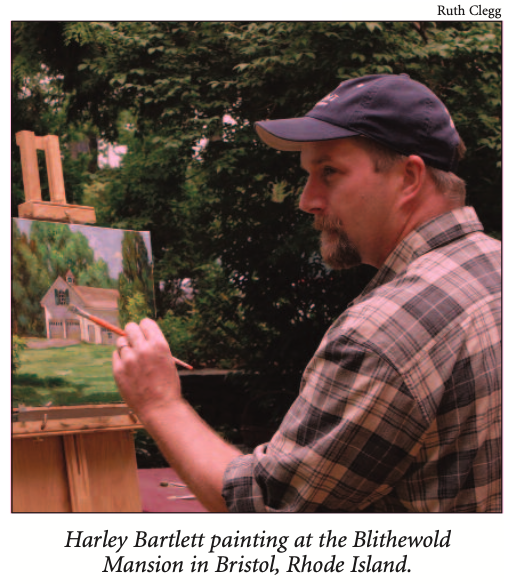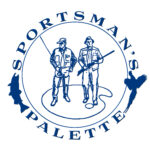Sportsman’s Palette Interviews Harley Bartlett
Following our interview with Sebastián Letelier, we got caught up with another great sporting artist, this time a little closer to our neck of the woods – Harley Bartlett.

SP: You have an extremely diverse body of work! How do you go from painting something small, say a small landscape or sporting scene on canvas, to working on a large-scale mural? Do you have any particular exercises or techniques you employ to transition between projects? Does each setting require a different ‘mindset’? Or are you able to just flow freely from one thing to the next without thinking about it too much?
HB: My interest in art, particularly painting, has long been very wide. Essentially, my starting point in my art making process has rested on craft. I’ve studied art of the past and have an ongoing interest in how the picture and mural has been created by these Past Masters. As a result my early education rested on mastering drawing and learning to see. Some of the art that I create is the not the result of predetermined direction but the result of being open to opportunity that presents itself to me. Of course, this is (like for many of us) promoted by economic necessity. Once I left school I was determined that my art “pay” for itself and find those opportunities.
So, back to the question how I transition from different sizes, subject matter or technique. Through much of my career this was determined by the demands of commercial work and balancing that with creating work that was “market ready” for the Fine Art world. The technical portion is mostly determined by common sense and learning the methods used to create these works. In mural painting, for example; how to transfer the sketch to the large canvas, how much paint to mix, what sort of paint (acrylic or oil) should be used, what sort of “marking system” is applicable, and so on. So, I needed to find and study methods through books and plain experience. This approach of varied considerations also works with easel painting as well.
The “idea” portion of the mural and or painting is a whole other set of considerations. With commercial work the idea may have already been established by the Art Director or Designer. I also painted murals designed by other artists so, again the “idea” part was already established. My job at this point was to work with the concept and have it work visually. And, as importantly, work “on budget”. At times I also managed other Artists in this process, which added more dimension to the whole project. So, with this I learned to compartmentalize what it was that I was doing.
The Fine Art idea portion required some research as far as the market goes. I spent time looking at Galleries that handled work (realism) similar to what I thought that I would create. What were the prices? Did I have interest in what I saw on the wall and could I create similar work? I also continued to study paintings of the past with the desire to match technically what I saw. One area that I felt comfortable in was the Landscape. So, that’s where I began. I also found in Art School that I could get a likeness of the model fairly easily. I considered portraiture but knew that I had little desire to specialize in the field. And, the market for portraiture was growing weaker in New England.
SP: Your portfolio of outdoor subjects includes a number of pretty diverse regions – everything from southern flats fishing, to freshwater fishing, upland hunting, to expansive western scenes, and even some European scenes. What inspires you most to paint such diverse regions?
HB: Once I felt that I had reasonably mastered my drawing and painting skills I expanded my subject matter. I balance much with my interests. I am a hunter, for example, so to explore and paint pictures about that activity seems natural. I grew up around Horses, so I painted them. That led to rural scenes with cows. That led, to animals of the West. I grew up learning to sail on Long Island Sound, so I have long painted marine scenes with boats. This requires mastering sky and water among other things. So, even though I am an occasional fisherman, painting those scenes takes into consideration of all my interests and skills.
SP: Is there any one person, or group of people, in your life that inspired you to become an artist?
HB: Art runs in my family. My Mother was very talented in the arts and crafts. My two older sisters, (who are closer in age to me than my younger sister) and I were encouraged as youngsters to draw, paint, etc. We were sent to summer programs for this as well. My maternal Grandparents were both talented amateur artists. So, this activity was considered important and encouraged.
SP: Is there any advice or wisdom you’d give to someone trying to start their career as a sporting or landscape artist?
HB: Learn your craft and learn to see. Study the work of those who you would emulate. Learn what you can of their career. Do the same with your contemporaries. (Social Media is a great way to start.) Realize that Art is a business and treat it as such. It won’t hurt to become familiar with the basics of Bookkeeping, filing and other business practices. Be a Professional because you are entering into a Profession.
SP: Do you have one particular favorite subject to paint?
HB: No. I have an ongoing love affair with all that I find in Painting.
SP: If you could travel anywhere in the world to fly fish and paint, where would you choose?
HB: Montana.
SP: Who is your favorite artist (other than yourself), dead or alive, sporting subjects or non-sporting subjects?
HB: Too many to count.
